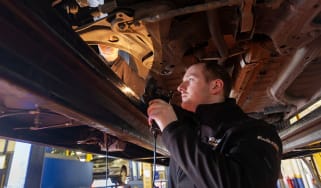What's the best oil for my car?
Engine oil isn’t entirely straightforward – here’s what you need to know

Not all engine oils are created equal, so it's important to understand which one you need for your car. The right engine oil will lubricate the moving metal components in your car’s engine, keeping everything running smoothly and preventing excessive friction. Using the wrong engine oil, or simply not using enough, increases the risk of mechanical components grinding against each other, leading to overheating that can cause serious damage.
Engine oil should be routinely changed in line with the manufacturer’s recommended service interval, although it's recommended that you keep an eye on the oil level throughout the year in case it needs a top-up. Engine oil is categorised by ‘grade’, with different grades being used for different engines and fuel types. Your car’s handbook will specify which oil grade and how much is needed for your car, and should always be your first port of call if you’re unsure about how to maintain your car.
Read on below to find out more about different oil grades, types of oil and which one you will need for your car.
What are oil grades?
Oil grades are used to categorise engine oils by their viscosity – i.e. how thick it is. As a general rule, modern engines are engineered and tested to much tighter tolerances than before, and as a result, they tend to need much thinner grades of oil than the oil used in older cars. There are many different grades and the naming system can be confusing, so here’s what you need to know.
Most modern oils are what’s called ‘multigrade oils’. This means they have additives in them which enable them to change thickness depending on the heat of the engine. These have two different grade numbers to denote the different thickness when hot or cold.
 How to check and top up your engine oil
How to check and top up your engine oil
You’ll see this when shopping for engine oil; the grade will be printed on the bottle, denoted by two numbers with a letter ‘W’ and dash in between, for example 10W-30 or 5W-40.
The first grade has the letter ‘W’ beside it, which stands for ‘winter’ and shows how cold weather will affect the oil’s performance. When the temperature is warmer, the oil performs differently and is represented by the second grade. These oil grades should be found in your car’s manual.
What are oil specifications?
Different oils have varying specifications as well as types and grades. The European Automobile Manufacturers Association (ACEA) categorises oils using its ACEA specification, a system adopted by most European and Asian carmakers. It will be displayed in your car’s handbook. Most petrol cars will use one of the following oil specifications:
- A1 – Fuel economy petrol
- A3 – High performance petrol and/or extended drain
- A5 – Fuel economy petrol with extended-drain capability
Some oils are developed to withstand up to 18,000 miles or two years of driving before they need changing. Called ‘longlife,’ they enable carmakers to offer longer service intervals.
What is the best oil for a diesel car?
Diesel engines need different oil from petrol engines, as they often require different viscosities and oil additives. Diesel cars fitted with a diesel particulate filter (DPF) require a separate type of oil, listed below.
Like the oil for petrol engines, diesel engine oil is offered in a range of ratings. Your handbook will tell you which is suitable for your car:
- B1 – Fuel economy diesel
- B3 – High performance and/or extended drain
- B4 – For direct-injection passenger-car diesel engines
- B5 – Fuel economy diesel with extended-drain capability
If your car has a diesel particulate filter (DPF), you must use a ‘low SAPS’ oil or you risk blocking the DPF. SAPS stands for Sulphated Ash, Phosphorus and Sulphur – all substances that can build up in the DPF and cause a blockage over time. Look for the following oils:
- C1 Low SAPS (0.5% ash) fuel-efficient
- C2 Mid SAPS (0.8% ash) fuel-efficient, performance
- C3 Mid SAPS (0.8% ash) less fuel-efficient; more bias on performance
Each carmaker will choose the SAPS level most effective for their engine design and so will choose a different ACEA C rating as appropriate.
What is synthetic oil?
Synthetic oils perform the same function as mineral oils, but they are engineered using artificial chemical compounds, rather than just refined crude oil. They offer better lubrication performance than typical mineral oils, but are typically more expensive. Your car’s handbook will tell you if it’s necessary to use synthetic oil.
Fully synthetic oils are the most expensive but semi-synthetic oils, which combine synthetic and mineral oils, are more widely used.
Do I need to change the oil filter?
It’s recommended that the oil filter is changed along with the engine oil, since you don’t want any old impurities getting back into your engine. It’ll be changed, along with the oil, at each service.
Check your car’s handbook or with your dealer how often the oil and filter should be changed. Fortunately, you don’t need to change the filter if you’re simply topping up the oil between services.
Frequently Asked Questions
Car care made simple...
Recommended

MoT guide: cost, info and what happens if your car fails
Most Popular
Tips & advice

Car dashboard warning lights: what does each symbol mean?

Electric car charging stations: public networks, charger types, apps and maps






